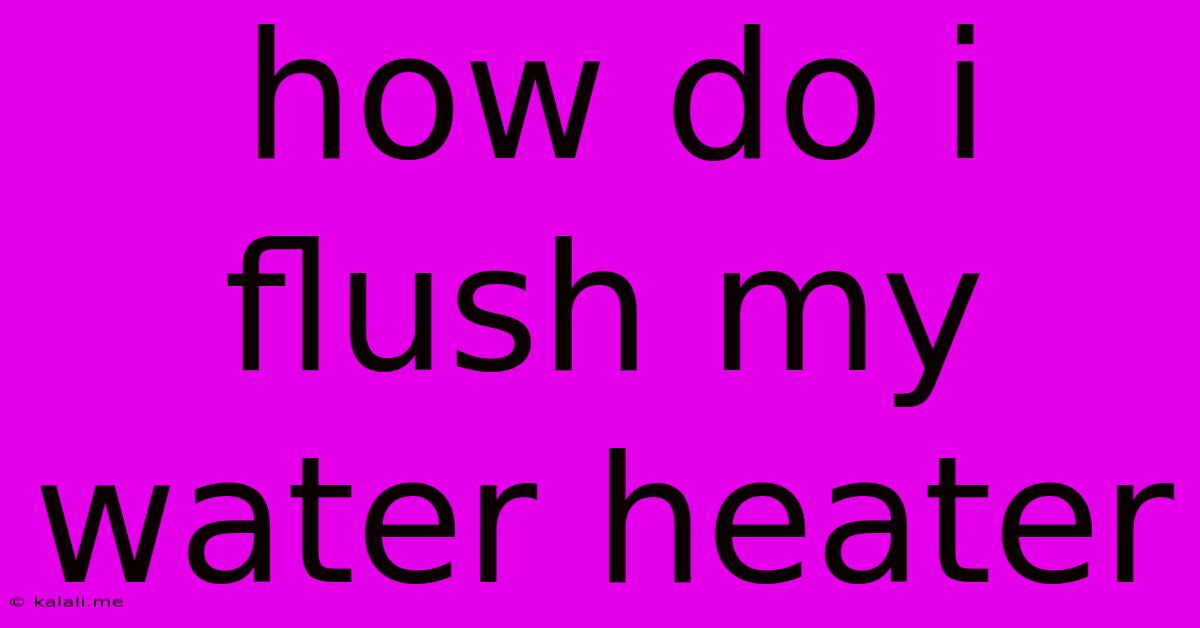How Do I Flush My Water Heater
Kalali
Jun 11, 2025 · 4 min read

Table of Contents
How to Flush Your Water Heater: A Step-by-Step Guide for a Longer-Lasting Appliance
Is your water heater making strange noises? Is your hot water less hot than it used to be? These could be signs that your water heater needs a good flushing. Sediment buildup is a common problem that reduces efficiency and can shorten the lifespan of your water heater. Fortunately, flushing your water heater is a relatively straightforward DIY task that can save you money on repairs and energy bills. This comprehensive guide will walk you through the process, regardless of whether you have a gas or electric water heater.
Why Flush Your Water Heater?
Over time, minerals in your water settle at the bottom of your tank, forming sediment. This sediment acts as insulation, reducing the efficiency of your water heater and forcing it to work harder to heat the water. This leads to higher energy bills and can even cause premature failure of the heating element or burner. Regular flushing removes this sediment, restoring efficiency and extending the life of your appliance. Signs you need to flush include:
- Reduced hot water: Sediment reduces the tank's capacity.
- Loud noises (popping, rumbling): Sediment can cause the tank to overheat and make noise.
- Cloudy or discolored water: Sediment can make your water look murky.
- Increased energy bills: Inefficient heating due to sediment buildup increases energy consumption.
Tools and Materials You'll Need:
- Garden hose: To drain the water heater.
- Bucket or container: To catch the drained water.
- Adjustable wrench: To loosen and tighten fittings (if necessary).
- Gloves: To protect your hands.
- Safety glasses: To protect your eyes.
- Flashlight: To check for sediment. (Optional)
How to Flush Your Water Heater: A Step-by-Step Guide
This process applies generally to both gas and electric water heaters, but minor differences might exist depending on your specific model. Always consult your water heater's manual for specific instructions and safety precautions.
1. Turn Off the Power or Gas:
- Electric Water Heater: Turn off the power breaker to the water heater.
- Gas Water Heater: Turn off the gas supply valve to the water heater.
2. Turn Off the Cold Water Supply:
Locate the cold water supply valve to your water heater and turn it off. This valve is usually located near the top of the tank.
3. Attach the Hose:
Connect one end of the garden hose to the drain valve located at the bottom of the water heater. This is usually a 1/2 inch fitting. Secure it tightly.
4. Direct the Hose:
Direct the other end of the hose to a suitable drain, such as a floor drain or outside where the wastewater can safely flow away. Ensure you have enough space for the amount of water being discharged.
5. Open the Drain Valve:
Carefully open the drain valve. The water will initially flow out quickly; be prepared for this.
6. Flush the Tank:
Let the water drain until it runs clear. This could take several minutes or even longer, depending on the amount of sediment buildup. Once the water starts to run clear, you can turn the drain valve off.
7. Inspect the Sediment (Optional):
Once the water has drained, you can use a flashlight to see the sediment buildup in your tank. This will give you an idea of how much sediment was removed and if more frequent flushing is necessary.
8. Refill and Turn On the Water Supply:
Turn the water supply back on and allow the tank to refill completely. This could take a while.
9. Turn On the Power or Gas:
Once the tank is full, turn the power (electric) or gas (gas) supply back on.
10. Check for Leaks:
After turning the power or gas back on, thoroughly check all connections for any leaks.
Frequency of Flushing:
How often you should flush your water heater depends on the mineral content of your water. In areas with hard water, flushing every 6-12 months is recommended. In areas with softer water, you might only need to flush every 2-3 years. Always consult your water heater manual for the manufacturer's recommendation.
Important Safety Precautions:
- Always turn off the power or gas supply before starting the process.
- Wear gloves and safety glasses to protect yourself from hot water and potential debris.
- Be aware that the water will be hot initially. Allow it to cool somewhat before handling.
- If you're uncomfortable performing this task yourself, contact a qualified plumber.
By following these steps, you can effectively flush your water heater, prolong its lifespan, and save money on energy costs. Remember, prevention is key, so regular flushing is a simple maintenance task that can pay off big in the long run.
Latest Posts
Latest Posts
-
105 Is 35 Of What Number
Jun 12, 2025
-
The Element That Has The Atomic Number 17 Is
Jun 12, 2025
-
Difference Between Subsistence And Commercial Agriculture
Jun 12, 2025
-
Action Words That Begin With S
Jun 12, 2025
-
The Thick Muscular Layer Of The Uterus Is The
Jun 12, 2025
Related Post
Thank you for visiting our website which covers about How Do I Flush My Water Heater . We hope the information provided has been useful to you. Feel free to contact us if you have any questions or need further assistance. See you next time and don't miss to bookmark.